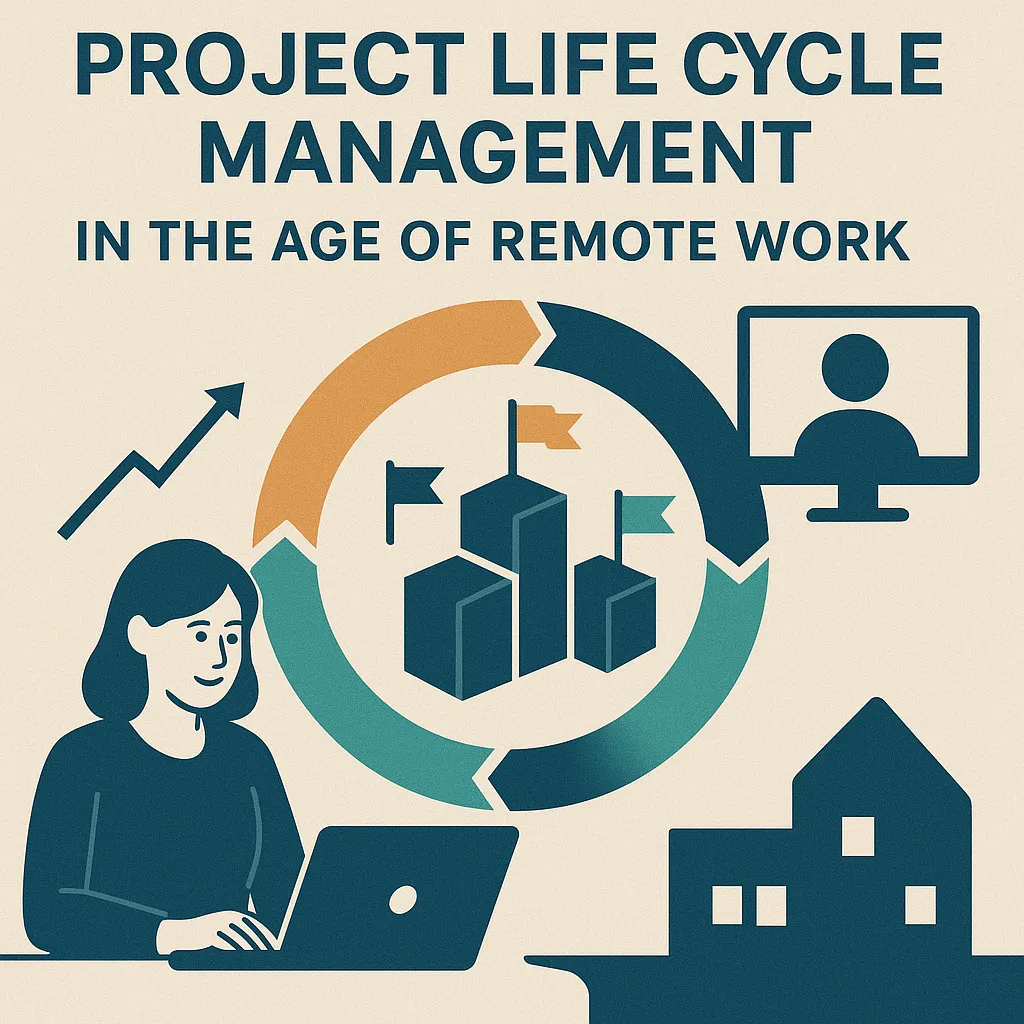Introduction to Project Life Cycle Management
Understanding the project life cycle is crucial for ensuring successful outcomes, especially in the context of remote work. This section aims to provide a foundational understanding of project life cycle management and its relevance for remote project teams.
Definition of Project Life Cycle Management
Project life cycle management refers to the structured approach to managing a project from its inception to its completion. It encompasses a series of phases that guide project teams through the various stages of a project, ensuring that objectives are met efficiently and effectively. This process is essential for maintaining clarity, organization, and focus throughout the project, particularly when team members are dispersed across different locations.
Importance of the Life Cycle in Project Success
The life cycle serves as a roadmap for project managers and teams, outlining the necessary steps to achieve project goals. Its importance can be highlighted through several key aspects:
- Clarity and Structure: By following a defined life cycle, teams can better understand their roles and responsibilities at each stage, which is particularly vital in remote settings where communication may be less direct.
- Risk Management: A well-defined life cycle allows for the identification and mitigation of risks at various stages, enhancing the likelihood of project success.
- Resource Allocation: Understanding the life cycle helps in planning and allocating resources effectively, ensuring that remote teams have what they need to succeed at each phase.
Overview of Traditional Life Cycle Phases
The traditional project life cycle is typically divided into five key phases:
- Initiation: This phase involves defining the project, identifying stakeholders, and establishing project objectives. It sets the foundation for all subsequent activities.
- Planning: During this phase, detailed planning occurs, including the development of project schedules, budgets, and resource plans. Effective planning is crucial for remote teams to align their efforts and expectations.
- Execution: This phase is where the actual work of the project takes place. Teams implement the project plan, and effective communication becomes essential, especially in a remote environment.
- Monitoring and Controlling: Throughout the execution phase, project managers must monitor progress and make adjustments as necessary. This phase ensures that the project stays on track and meets its objectives.
- Closure: The final phase involves completing all project activities, obtaining stakeholder acceptance, and conducting a post-project evaluation. This phase is critical for capturing lessons learned, which can inform future projects.
Impact of Remote Work on Traditional Life Cycle Management Practices
The shift to remote work has significantly influenced traditional life cycle management practices. Some of the key impacts include:
- Communication Challenges: Remote teams may face difficulties in maintaining effective communication, which can hinder collaboration during the execution and monitoring phases. Project managers must leverage digital tools to facilitate clear and consistent communication.
- Flexibility in Planning: Remote work often requires more adaptable planning processes. Teams may need to adjust timelines and resource allocations based on changing circumstances, making agile methodologies increasingly relevant.
- Technology Utilization: The reliance on technology for project management has intensified. Tools for collaboration, task management, and progress tracking are essential for remote teams to navigate the life cycle effectively.
- Cultural Considerations: Remote teams may consist of members from diverse cultural backgrounds, which can impact team dynamics and decision-making processes. Project managers must be aware of these differences and foster an inclusive environment.
The Challenges of Remote Project Management
Remote work has become a prevalent mode of operation. While it offers flexibility and access to a global talent pool, it also presents unique challenges that can complicate the life cycle management process. Here are some of the key challenges faced by remote teams in managing project life cycles:
- Communication Barriers and Their Impact on Collaboration: Effective communication is the cornerstone of successful project management. In remote settings, teams often rely on digital communication tools, which can lead to misunderstandings and misinterpretations. The absence of non-verbal cues, such as body language and tone, can hinder collaboration and create confusion among team members. This can result in delays and a lack of cohesion in project execution.
- Time Zone Differences and Scheduling Conflicts: Remote teams often span multiple time zones, which can complicate scheduling meetings and coordinating tasks. This disparity can lead to delays in decision-making and project timelines, as team members may not be available simultaneously. Additionally, the challenge of finding suitable times for all members can lead to frustration and decreased productivity.
- Lack of Face-to-Face Interaction Affecting Team Dynamics: The absence of in-person interactions can impact team dynamics significantly. Building trust and rapport among team members is more challenging without face-to-face meetings. This lack of personal connection can lead to feelings of isolation and disengagement, which can affect team morale and overall project performance.
- Difficulty in Tracking Progress and Accountability Remotely: Monitoring project progress and ensuring accountability can be more complex in a remote environment. Traditional methods of tracking, such as in-person check-ins and visual progress boards, may not translate well to virtual settings. Project managers may struggle to maintain visibility over team members’ contributions, leading to potential delays and a lack of clarity regarding responsibilities.
Adapting the Life Cycle Management Process for Remote Teams
Particularly in the context of remote work, adapting life cycle management practices is essential for ensuring project success. As remote teams become increasingly common, project managers and team leaders must implement strategies that cater to the unique challenges and opportunities presented by this mode of operation. Here are key strategies to effectively adapt the life cycle management process for remote teams:
1. Utilizing Digital Tools for Enhanced Communication
Effective communication is the backbone of successful project management, especially for remote teams. Leveraging digital tools can significantly enhance collaboration and information sharing. Consider the following tools:
- Slack: This messaging platform allows for real-time communication, enabling team members to discuss project updates, share files, and collaborate on tasks seamlessly.
- Zoom: Video conferencing tools like Zoom facilitate face-to-face interactions, which are crucial for building rapport and ensuring clarity in discussions.
- Trello: A project management tool that helps teams organize tasks visually, Trello allows for tracking progress and assigning responsibilities, making it easier to manage workflows remotely.
By integrating these tools into the life cycle management process, teams can maintain clear lines of communication and ensure that everyone is aligned on project goals and timelines.
2. Establishing Clear Guidelines and Expectations for Remote Work
To foster a productive remote work environment, it is vital to establish clear guidelines and expectations. This includes:
- Defining Roles and Responsibilities: Clearly outline each team member’s role within the project to avoid confusion and overlap.
- Setting Work Hours: Establishing core hours for availability can help synchronize team efforts and facilitate real-time collaboration.
- Communication Protocols: Specify how and when team members should communicate, whether through daily stand-ups, weekly check-ins, or asynchronous updates.
By setting these expectations, project managers can create a structured environment that promotes accountability and productivity among remote team members.
3. Implementing Agile Methodologies to Enhance Flexibility and Responsiveness
Agile methodologies are particularly well-suited for remote teams, as they emphasize adaptability and iterative progress. Key practices include:
- Regular Sprints: Organizing work into short, manageable sprints allows teams to focus on specific tasks and adjust priorities based on feedback and changing circumstances.
- Daily Stand-ups: Brief daily meetings help teams stay aligned, discuss challenges, and celebrate progress, fostering a sense of community and shared purpose.
- Retrospectives: Conducting regular retrospectives enables teams to reflect on their processes, identify areas for improvement, and implement changes quickly.
By adopting agile practices, remote teams can respond more effectively to challenges and changes, ensuring that projects remain on track.
4. Creating Virtual Environments that Foster Collaboration and Engagement
To maintain team morale and engagement in a remote setting, it is essential to create virtual environments that encourage collaboration. Strategies include:
- Virtual Team-Building Activities: Organizing online games, quizzes, or social events can help strengthen team bonds and improve communication.
- Collaborative Platforms: Utilizing platforms like Miro or Google Workspace allows team members to brainstorm, share ideas, and work together in real-time, simulating an in-person collaborative experience.
- Recognition and Feedback: Regularly acknowledging team members’ contributions and providing constructive feedback can enhance motivation and foster a positive team culture.
By focusing on collaboration and engagement, project managers can create a supportive remote work environment that drives project success.
Best Practices for Each Phase of the Project Life Cycle
Effective project life cycle management is crucial for ensuring that teams remain productive and engaged. Here are actionable insights and best practices tailored for each phase of the project life cycle, specifically designed for remote project teams.
1. Initiation
- Define Project Goals and Scope with Remote Stakeholders: Begin by clearly articulating the project’s objectives and scope. Engage remote stakeholders through video calls or collaborative documents to ensure everyone has a shared understanding of the project’s direction.
- Utilize Virtual Brainstorming Sessions to Gather Input: Leverage tools like Miro or MURAL for interactive brainstorming sessions. This allows team members to contribute ideas in real-time, fostering creativity and inclusivity.
- Establish Project Charters Collaboratively Online: Create a project charter that outlines the project’s purpose, objectives, and stakeholders. Use collaborative platforms like Google Docs or Microsoft Teams to draft and finalize this document collectively.
2. Planning
- Leverage Project Management Software to Create and Share Plans: Utilize tools such as Asana, Trello, or Monday.com to develop detailed project plans. These platforms facilitate transparency and allow team members to access and update their tasks easily.
- Incorporate Regular Check-Ins to Align Team Members: Schedule weekly or bi-weekly check-ins to discuss progress, address challenges, and realign on goals. This keeps everyone on the same page and fosters accountability.
- Use Visual Aids (Gantt Charts, Kanban Boards) to Track Tasks: Visual tools help in tracking project timelines and task statuses. Gantt charts provide a timeline view, while Kanban boards allow for easy visualization of task progress, making it easier for remote teams to stay organized.
3. Execution
- Encourage Open Communication to Address Issues in Real-Time: Foster a culture of open communication through platforms like Slack or Microsoft Teams. This enables team members to raise concerns and seek assistance promptly, minimizing delays.
- Implement Virtual Team-Building Activities to Maintain Morale: Organize regular virtual team-building exercises to strengthen relationships and boost morale. Activities like online games or virtual coffee breaks can enhance team cohesion.
- Set Up Clear Reporting Structures to Monitor Progress: Establish clear reporting lines and expectations for updates. Regular status reports can help track progress and identify any potential roadblocks early on.
4. Monitoring
- Regularly Review Project Metrics and KPIs Digitally: Use dashboards in project management software to monitor key performance indicators (KPIs) and project metrics. This allows for real-time tracking of project health and progress.
- Use Feedback Loops to Improve Processes Continually: Implement mechanisms for continuous feedback, such as surveys or suggestion boxes, to gather insights from team members on processes and workflows.
- Conduct Virtual Retrospectives to Assess Team Performance: Schedule retrospectives at the end of each project phase to discuss what went well and what could be improved. This practice encourages reflection and continuous improvement.
5. Closure
- Facilitate a Virtual Project Closure Meeting to Celebrate Successes: Host a virtual meeting to celebrate the completion of the project. Recognizing achievements fosters a sense of accomplishment and motivates team members for future projects.
- Document Lessons Learned in a Shared Digital Repository: Create a centralized location for documenting lessons learned throughout the project. This repository can serve as a valuable resource for future projects and help avoid repeating mistakes.
- Ensure All Deliverables are Completed and Handed Off Properly: Conduct a final review of all deliverables to ensure they meet the project requirements. Proper handoff procedures should be established to transition deliverables to stakeholders or clients effectively.
By implementing these best practices, remote project teams can navigate the complexities of project life cycle management more effectively, ensuring successful project outcomes even in a virtual environment.
Tools and Technologies Supporting Remote Life Cycle Management
Particularly in the context of remote work, leveraging the right tools and technologies is crucial for effective life cycle management. This section explores key tools and technologies that can enhance the life cycle management process for remote teams, ensuring that project leaders and managers can maintain productivity and cohesion despite physical distances.
Overview of Project Management Tools
- Asana: Asana is a versatile project management tool that allows teams to plan, organize, and track their work. It offers features such as task assignments, timelines, and project dashboards, which are essential for managing the various phases of a project life cycle. Remote teams can benefit from its ability to visualize project progress and deadlines, ensuring everyone stays aligned.
- Jira: Primarily used in software development, Jira is an agile project management tool that supports issue tracking and project planning. Its customizable workflows and reporting features make it ideal for remote teams that need to adapt quickly to changing project requirements. Jira facilitates collaboration by allowing team members to comment on tasks and share updates in real-time.
- Microsoft Teams: Microsoft Teams serves as a hub for teamwork, integrating chat, video conferencing, and file sharing. It enhances communication among remote team members, making it easier to discuss project updates and collaborate on documents. The integration with other Microsoft Office tools further streamlines the project management process.
Benefits of Cloud-Based Solutions for Document Sharing and Collaboration
Cloud-based solutions have revolutionized how remote teams manage documents and collaborate on projects. Key benefits include:
- Accessibility: Team members can access documents from anywhere, ensuring that everyone has the latest information at their fingertips, regardless of their location.
- Real-Time Collaboration: Tools like Google Drive and Dropbox allow multiple users to work on documents simultaneously, facilitating immediate feedback and reducing the time spent on revisions.
- Version Control: Cloud solutions often include version history features, enabling teams to track changes and revert to previous versions if necessary, which is vital for maintaining project integrity.
Role of Communication Platforms in Maintaining Team Cohesion
Effective communication is the backbone of successful remote project management. Platforms such as Slack, Zoom, and Microsoft Teams play a pivotal role in fostering team cohesion by:
- Facilitating Instant Communication: These platforms allow for quick exchanges of ideas and updates, reducing the delays often associated with email communication.
- Encouraging Team Engagement: Features like video calls and virtual team-building activities help maintain personal connections among team members, which is essential for morale and collaboration.
- Providing Structured Communication: Channels and threads in communication tools help organize discussions around specific projects or topics, making it easier for team members to find relevant information.
Emerging Technologies (AI, Automation) That Can Streamline Project Management
The integration of emerging technologies such as artificial intelligence (AI) and automation is transforming project management practices, particularly for remote teams. These technologies offer several advantages:
- AI-Powered Analytics: Tools that utilize AI can analyze project data to provide insights into performance trends, helping project managers make informed decisions and adjustments throughout the project life cycle.
- Automation of Repetitive Tasks: Automation tools can handle routine tasks such as scheduling meetings, sending reminders, and updating project statuses, freeing up team members to focus on more strategic activities.
- Enhanced Resource Management: AI can assist in resource allocation by predicting project needs based on historical data, ensuring that teams are adequately staffed and equipped to meet project demands.
Conclusion and Future Trends
Particularly in the context of remote work, adapting life cycle management practices has become essential for ensuring project success. As remote teams continue to proliferate, the importance of a structured approach to managing the project life cycle cannot be overstated. Here are some key takeaways and future trends to consider:
Importance of Adaptation: The shift to remote work has necessitated a reevaluation of traditional project life cycle management practices. Remote teams face unique challenges, such as communication barriers and varying time zones, which can impact collaboration and project outcomes. By adapting life cycle management processes—such as planning, execution, monitoring, and closure—project managers can enhance team cohesion and ensure that all members are aligned with project goals. This adaptation not only improves efficiency but also fosters a culture of accountability and transparency within remote teams.
Future Predictions: Looking ahead, several trends are likely to shape the future of remote project management:
- Increased Use of Technology: The integration of advanced project management tools and software will continue to rise, enabling better tracking, communication, and collaboration among remote teams. Tools that facilitate real-time updates and feedback will become indispensable.
- Focus on Agile Methodologies: As remote work environments evolve, agile project management practices will gain prominence. These methodologies allow for flexibility and quick adjustments, which are crucial in dynamic remote settings.
- Emphasis on Soft Skills: The ability to lead and manage remote teams effectively will increasingly depend on soft skills such as emotional intelligence, communication, and conflict resolution. Project managers will need to cultivate these skills to navigate the complexities of remote team dynamics.
- Embracing Change and Continuous Improvement: The transition to remote work is not merely a temporary adjustment; it represents a fundamental shift in how projects are managed. Project leaders are encouraged to embrace this change and view it as an opportunity for continuous improvement. By regularly assessing and refining life cycle management practices, teams can enhance their resilience and adaptability in the face of future challenges. This proactive approach will not only lead to better project outcomes but also foster a culture of innovation and growth within remote teams.
In conclusion, as remote work becomes a permanent fixture in the project management landscape, adapting life cycle management practices will be crucial for success. By staying attuned to emerging trends and committing to continuous improvement, project managers can lead their teams to thrive in this new era of work.
Find out more about Shaun Stoltz https://www.shaunstoltz.com/about/.
This post was written by an AI and reviewed/edited by a human.



